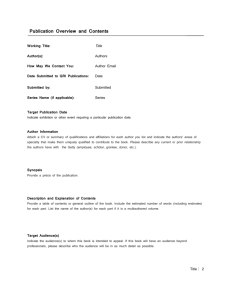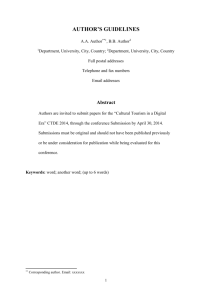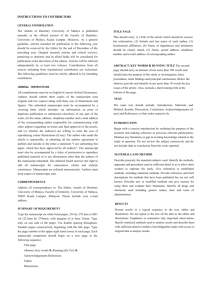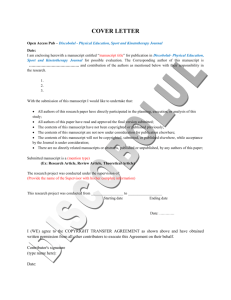Author`s Manual for - Conference
advertisement
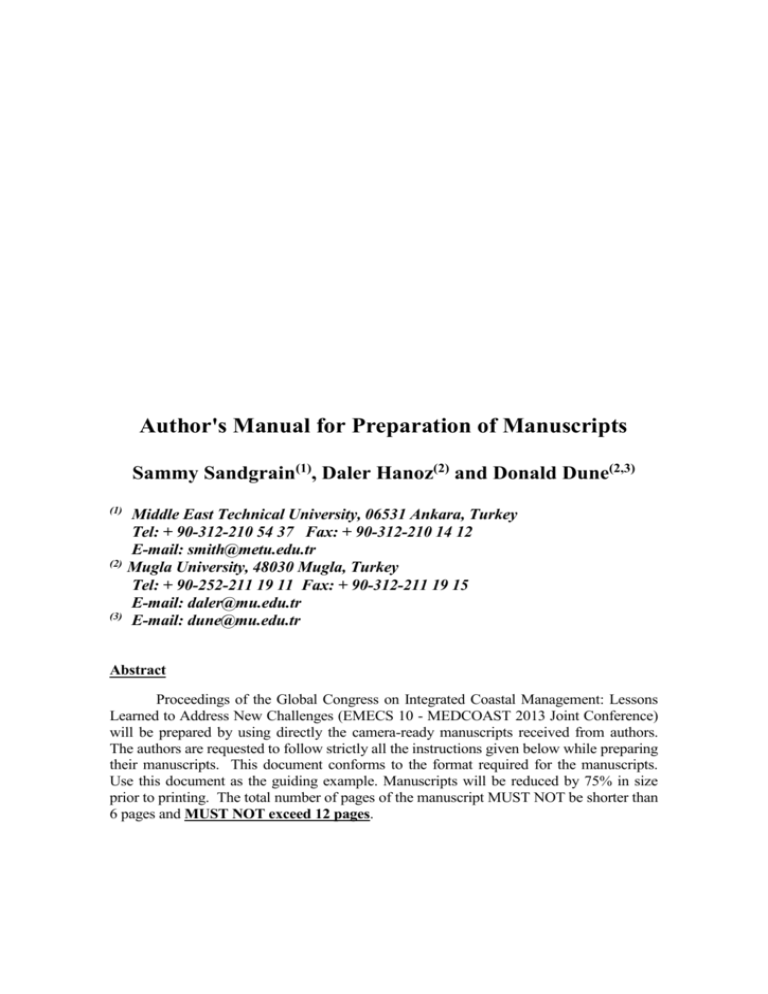
Author's Manual for Preparation of Manuscripts Sammy Sandgrain(1), Daler Hanoz(2) and Donald Dune(2,3) (1) Middle East Technical University, 06531 Ankara, Turkey Tel: + 90-312-210 54 37 Fax: + 90-312-210 14 12 E-mail: smith@metu.edu.tr (2) Mugla University, 48030 Mugla, Turkey Tel: + 90-252-211 19 11 Fax: + 90-312-211 19 15 E-mail: daler@mu.edu.tr (3) E-mail: dune@mu.edu.tr Abstract Proceedings of the Global Congress on Integrated Coastal Management: Lessons Learned to Address New Challenges (EMECS 10 - MEDCOAST 2013 Joint Conference) will be prepared by using directly the camera-ready manuscripts received from authors. The authors are requested to follow strictly all the instructions given below while preparing their manuscripts. This document conforms to the format required for the manuscripts. Use this document as the guiding example. Manuscripts will be reduced by 75% in size prior to printing. The total number of pages of the manuscript MUST NOT be shorter than 6 pages and MUST NOT exceed 12 pages. Introduction The manuscript must be prepared by using Microsoft Word for Windows word processor and STRICTLY obeying the instructions mentioned in this document. Manuscripts that do not STRICTLY follow the instructions described in this document will not be edited and the papers will be excluded from the conference program. Paper General Structure The structure of a paper should be as follows (Those marked by * are essential): - The paper title and name(s) of the author(s)*; - Abstract*; - Introduction*; - Section(s) of the main text*; - Results (if applicable) - Conclusions*; - Acknowledgements (if applicable) - References*; - Appendices (if applicable). Manuscript Format Page format Document should be formatted to use A4 (21 cm x 29.7 cm) sized paper. Use 12 point Times New Roman typeface (the text in this manual is in 12 points Times New Roman). The manuscript must be single spaced and justified throughout. The following margins should be strictly obeyed: Bottom margin is 2.5 cm and all other margins (top, right, left) are 3.0 cm. A full page of text and/or illustrations must be achieved whenever there is a need to avoid “widows” and “orphans”. Widow is the last line of paragraph alone at top of a page and orphan is the first line of paragraph alone at bottom of a page. Authors are urged to ensure that the number of pages of the manuscript (including text, illustrations, references and appendices) is not more than 12. General layout The title of the paper should not be longer than fifty (50) characters. Title should be placed at about 9.5 cm down from the top of the first page. The title font size should be 18, font style should be bold and alignment should be centred. The title should be in title case format (lower-case except the first letters of the title which must be capitalized). It must be followed after one line of space by the names of all authors. The font size should be 16, font style should be bold and alignment should be centred. The affiliations (together with postal addresses, fax and phone numbers) should be placed one space after the names of authors. The font size should be 13, font style should be bold and italic, and alignment should be left justified. It is necessary that the paper starts with an abstract. The heading Abstract should be placed two spaces after the affiliations. All section headings should be left justified and should not be numbered. They should be in title case format (lower-case except the first letters of the heading which must be capitalized). Headings of the primary-sections should be bold and underlined. Headings of the secondary-sections should be bold and italic and in sentence case format. Further sub-headings can be in italic. The first line of each paragraph should be indented by 1.25 cm. One-line space should be left between paragraphs and below each heading. Two-line space should be left before headings (i.e. between sections/sub-sections). Illustrations All illustrations (figures, photos, tables ... etc.) must be in digital form as inserted in the manuscript. Illustrations should be placed inside the text right after they are first mentioned (as close as possible). Figures and photos must be numbered, and captions must be written directly beneath them as shown below by Fig. 1. Usage of text boxes while writing figure captions should be avoided. Manuscripts containing colour figures will be charged based on the prices in Table 1. Tables must also be numbered and captions must be written directly above them as illustrated by Table 1 below. Except special illustrations, ALL illustrations should be in editable format Shading is NOT allowed in tables. Lettering should be neatly printed and be large enough to assure legibility after size reduction of about 75%. Together with their captions, illustrations must not exceed the page margins specified earlier. Although it is not preferable, you may lay out an illustration in double-page spread starting on an even-numbered page if you find this as essential. All figures and tables must be cited inside the text. Example figure (or photo) Fig. 1: Example figure and its caption. The figures and their captions should be left intended. The spacing above figure and below its caption should be 18 pt while the spacing between the figure and the caption should be 6 pt. If the figure caption is longer than one line, all lines should be aligned to the first line. Please note that this example is arranged in the required format. Table 1: Colour printing prices. The spacing above table caption and below table should be 18 pt while the spacing in between should be 6 pt. If the table explanation is long, all lines should be aligned with the first line. Please note that this example is arranged in the required format. Number of Pages Total Price (Euro) 1 page 2 pages 3 pages 3< 50 80 110 20 per page Mathematics, symbols and units All mathematics and other special symbols included in the text should have typed characters. Equations should be left justified and their numbers should be right justified as given by (1). Y=AX+B (1) The use of the International System of Units (SI units) as the primary units is required. References All references should appear all together at the end of the paper. They should not be numbered. References need to be listed alphabetically by last name of the first author. When two or more references by the same author are listed, year of publication is taken into account, and the earliest work is listed first. Wherever reference is made in the text to an author's work, the author(s) and year of publication should appear in parentheses like: Goda (1985), Isaacson and MacKenzie (1981) and Mathiesen et al. (1994). The corresponding reference items are shown in References Section below. All references appearing at the end of the paper must be cited inside the text. Keywords Please DO NOT forget to provide up to 10 keywords relevant to your paper at the end of the manuscript. These will be used to index the paper in the proceedings. Approvals and Copyright Transfer It is the author's responsibility to obtain all necessary approvals from the author's employer, etc., prior to submission of the paper. Please note that if an illustration (e.g. a figure or a photograph) has been published previously, it will be necessary for the author to obtain written permission from the original publisher for MEDCOAST to reprint the illustration. The form for transfer of copyright must be completed by the author and submitted before submitting the manuscript. No paper will be published in the Proceedings unless a transfer of copyright form has been received by the MEDCOAST Foundation. Conclusion PLEASE KINDLY BE INFORMED THAT THE FINAL ACCEPTANCE OF THE PAPER FOR INCLUSION IN THE CONFERENCE PROGRAM AND THE PROCEEDINGS WILL BE BASED ON THE REVIEW OF THE SUBMITTED MANUSCRIPT. References Make sure that all the references cited in the text of your paper appear in the “Reference list” and all references provided at the end of your paper are cited at least once in the text. Please carefully check the authors’ names and the publication years of your references. Guidelines to cite within the text: 1. The author’s surname should be followed by the year of publication like (Relini, 2000) or like “Relini (2000) has stated that …”. 2. If the referred publication is written by two authors, write both authors’ surname followed by the year of publication like (Bressan and Babbini, 2011) or like “Bressan and Babbini (2011) have shown …”. 3. If the referred publication is written by more than two authors, the surname of the first author should be used followed by “et al.” like (Frantzis et al., 2001) or like “The findings in Frantzis et al. (2001) are …”. 4. If more than one publication are referred at the same location in the text, the references should be arranged chronologically, and separated by semicolon like (Relini, 2000; Frantzis et al., 2001; Bressan and Babbini, 2011). Guidelines to prepare the reference list: The reference list must be arranged alphabetically by authors’ surnames. Whenever an author(s) has/have more than one reference in the list, chronological ordering should be followed among these references by the same author(s). For different types of references, the following formats must be respected: Journal papers: Authors’ surname should be followed by his/her initials. For papers with multiple authors, each authors surname and initials should be separated by comma. The surname and initials of the last author should be preceded by “and”. After all the names are included, the year of the publication should be given in parenthesis followed by a comma. Afterwards, the title of the paper should be written in sentence case within quotation marks followed by a comma. Then, the journal title should be written in italic followed by a comma. The volume number is indicated and next to it the issue number is written in parentheses. Lastly, the page numbers of the paper are written. Example: Frantzis, A., Gordon, J., Hassidis, G. and Komnenou, A. (2001), “The enigma of the harbor porpoise presence in the Mediterranean Sea”, Marine Mammal Science, 17 (4), 937-944. Detailed explanation of the formats for other types of references given below is not provided. You are expected to follow strictly the style of the provided examples. Papers in Special Volumes of Periodicals: Example: Güleç, N. and Hilton, D. R. (2006), “Helium and heat distribution in Western Anatolia, Turkey: relationship to active extension and volcanism”, In: Dilek, Y. and Pavlides, S. (Eds.), Post-collisional tectonics and magmatism in the eastern Mediterranean region, Geological Society of America Special Paper, 409, 305–319. Papers/chapters in Edited Books: Example: Pozdnyakov, D., Korosov, A. and Pettersson, L. (2008), “Visible and infrared remote sensing of the White Sea bio-geo-chemistry and hydrology”, In: Barale, V. and Gade, M. (Eds.), Remote Sensing of the European Seas, Springer Science+Business Media B.V., Dordrecht, The Netherlands, 129-140. Conference proceeding papers: Example: Williams, A. T. and Li, L. (2011), “Coastal scenery at beaches on Hong Kong Island, China”, In: Özhan, E. (Ed.), Proceedings of the Tenth International Conference on the Mediterranean Coastal Environment – MEDCOAST 11, 25-29 October, Rhodes, Greece, 359-368. Books: Example: Bonham-Carter, G.F. (1994), “Geographic Information Systems for Geoscientists: Modelling with GIS”, Pergamon, Oxford, United Kingdom, 398 p. Thesis: Example: Özyavuz, M. (2008), “Planning of İğneada-Demirköy part of Yıldız Mountains as a biosphere reserve”, Ph.D Thesis, University of Ankara, Ankara, Turkey. Reports: Example: Leake, S. and Prudic, D. E. (1988), “Documentation of a computer program to simulate aquifer-system compaction using the modular finite-difference groundwater-flow model”, USGS Open-File Report, 88-482. Webpages: Examples: USGS Earth explorer, http://earthexplorer.usgs.gov/. General Directorate of Mineral Research and Exploration. Geophysics maps. Ankara, http://www.mta.gov.tr/v2.0/eng/maps.php Software: Example: Environmental Systems Research Institute (ESRI 2011), ArcGIS Desktop, Release 10, Redlands, California, USA. Publications other than English: Example: Özhan, E. and Abdalla, S. (2002), “Türkiye Kıyıları Rüzgar ve Derin Deniz Dalga Atlası”, Kıyı Alanları Yönetimi Türk Milli Komitesi & MEDCOAST, Orta Doğu Teknik Üniversitesi, Ankara, 445 p. (in Turkish). Appendix Important Last Reminders for the Author(s): - Do not use at all the bold and italic characters except for headings and sub-headings, symbols, equations and Latin terms. Do not insert page numbers and headers. Make sure that all your graphs used inside the text are editable. Do not include the figure captions inside the figure and do not put the figure captions in text boxes. Do not use fonts smaller than 10 points in any figure (due to 75% reduction in scale while printing, smaller fonts cannot be read). THANK YOU FOR YOUR COLLABORATION!
